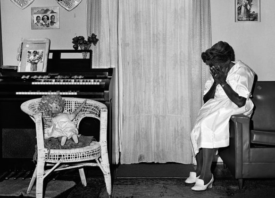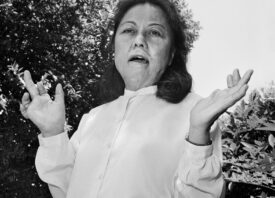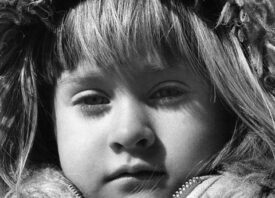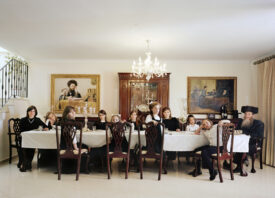Search this site
Empathy and Antipathy in the Photographs of Rosalind Fox Solomon

© Rosalind Solomon, Courtesy Bruce Silverstein Gallery, NY
In 1968, at the age of thirty-eight, Rosalind Fox Solomon began shooting photography during a trip to
Japan. She was living with a family who spoke little English and slept on their futon. The pictures were in color and mostly experimental. In the early 70s, Solomon would switch from color to a black-and-white square format and begin a forty-eight-year-long exodus from the suburban East Coast— settling, instead, in the role of far traveling portrait maker, shooting extensively in Israel, Peru, and South Africa, among others.Now, at the age of eighty-five, Solomon’s work is receiving the frequency of critical recognition that seemed to evade her. This past month she was featured at Bruce Silverstein Gallery and Brooklyn Museum. In February, her latest book, Got to Go, a collection of over seventy images that survey her work across time and geography, was published by MACK. The photographs all share an intensity of perception. They illuminate through an attraction to an unknowable interior, expressing the rough course of experience like a finely detailed biography or poem. Here, Rosalind speaks about the emotional and philosophical understandings of her work.

© Rosalind Solomon, Courtesy Bruce Silverstein Gallery, NY
I’d like to start by talking about empathy. Would you say your sense of empathy is rooted in sadness? What first compels you to stop and notice somebody?
“My sense of empathy is rooted in everything I have ever known. It connects with the many thoughts that float through my mind when I notice someone. Often, I feel a simultaneous sense of empathy as well as a sense of antipathy. I notice relationships between people: children and parents; friends, lovers, enemies. I empathize with happiness/sadness; love/anger; sexuality/impotence; parent/child. The dualities within an individual are most interesting. Empathy is not what always compels me to notice somebody. It can be a simultaneous sense of empathy and antipathy. A single word expressing one feeling is not sufficient to try to understand what I do.”

© Rosalind Solomon, Courtesy Bruce Silverstein Gallery, NY
You’ve said that you rather have “tension between [you] and the person photographed” because it “yields something more complex.” Is it possible to force a connection between you and somebody you’re photographing? Is that where this tension is?
“Sometimes the person tries very hard not to yield anything. That in itself makes a picture more interesting — the push-pull. How can I explain to you, exactly? I have spent years trying to tell myself what I am doing and then trying to find a language in which to tell others. How does a poet explain the complexity of a poem? For the most part, the viewer has to bring himself and his experiences to my images. As exactly as I can explain what’s in my pictures is to say that it’s the opposing forces within human beings, and the point at which there is a divergence that creates a tension – that’s what interests me most.”

© Rosalind Solomon, Courtesy Bruce Silverstein Gallery, NY
“There is no one truth, but there are an awful lot of objective facts. The more facts you get, the more facts you collect, the closer you come to whatever truth there is. The base of biography has to be facts.”
Robert Caro was talking in the Paris Review about biography, but he could very well be talking about a portrait too. A portrait can seen as a collection facts. To the camera, these facts would be rendered as appearances, a collection of gestures and details. Together it would all add up to a relation of that person’s story. Would you agree with this? What do you think?
“I am unconcerned about manipulating gestures. I let the gestures come as they may. There is something more important — a kind of electricity that occurs, both visual and visceral. It’s when there is a moment of ‘ahhhhhhhh I‘ve got it!’ It’s all a mix and the picture implies all of it. Otherwise, we could say it with words and we would not need the picture. It’s helpful to have some understanding of poetry and of literature to be an insightful photographer. Knowledge of theater, opera and art is also helpful. The great dramatists and great painters are wonderful teachers.”

© Rosalind Solomon, Courtesy Bruce Silverstein Gallery, NY
I use the word relation because I think this word’s action — to relate — comes closest to what your work is doing. It’s both retelling an account of somebody’s story and also connecting to and having empathy with whomever you’re photographing. Do you see your work as redeeming these stories against oblivion, against the absurd? Something else?
“Sometimes I do not have a clue about somebody’s story outside of how they are overtly functioning in the world. Before I became a photographer, my heightened sense of perception disturbed me. I saw and felt so much about people. Others did not see or feel the same things that I did. I was an artist, and I did not know it. When I became a photographer, I was no longer tormented by my keen sense of perception. Instead, that quality served my work. When I am photographing, or working in another media, I call upon my memories and emotions, current and past. They are my inner assistants, helpmates in the work that I do.”

© Rosalind Solomon, Courtesy Bruce Silverstein Gallery, NY
I imagine you’d have to distinguish from an exterior appearance, something akin to a figurative mask. Your work does feature many photographs of people obscured by costumes, shadows, and fabric. What’s the attraction of shooting people underneath these literal masks? How do you look past figurative ones?
“I cannot assume the role of an art critic as I view my images. The picture is invested with the power of the moment. Then the picture finds a context, or more than one context, beyond the moment. A picture can be like the line of a poem. A poet composes the poem with words and lines and then intersperses them. The same thing can happen with an image. Sometimes my work features people in costumes and costumes masks. They then become metaphors for the passions and rituals of life, in the same way that Kabuki represents extremes in a stylized way.”

© Rosalind Solomon, Courtesy Bruce Silverstein Gallery, NY
When talking about masks, I think I should also mention power. Power is usually performed with a mask: cops in their uniforms, let’s say, judges in their robes; power poses one should take to be respected. There’s a propriety to how it’s done. You were raised before the first wave of feminism, expected to play a role in your marriage, and have felt the oppression of power. Do you think feeling this burden allowed to you more clearly photograph the incongruity between performing and being a self?
“As a girl and as a married woman, I experienced the oppression of power. I struggled to recognize myself and to allow myself to flourish and grow into maturity. Had I been a man, I would have long ago gained the recognition for my work that is coming to me today. A novelist, feminist friend long ago said: when powerful women become old they are no longer threatening to men. They are treated as asexual and men are at ease with them. My work has given me my power and it continues to do so.”

© Rosalind Solomon, Courtesy Bruce Silverstein Gallery, NY
See more of Rosalind’s work here.
This interview originally appeared on PhotoWhoa, where you can read more work by Freddy Martinez. Freddy Martinez is a writer based in Brooklyn. You can see more of his writing here or follow him on Twitter and Instagram.



